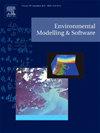通过结合燃料湿度和景观异质性的基于物理的方法模拟野火动力学
IF 4.6
2区 环境科学与生态学
Q1 COMPUTER SCIENCE, INTERDISCIPLINARY APPLICATIONS
引用次数: 0
摘要
人为的气候变化增加了热浪和干旱发生的可能性、严重程度和持续时间,从而加剧了野火的风险。数学和计算模型可以增强我们对野火传播动力学的理解。在这项工作中,我们提出了一个简化的平流-扩散-反应(ADR)模型,该模型考虑了燃料湿度的影响,并考虑了风、局部辐射、自然对流和地形。该模型通过表观热容量法明确地表示燃料水分的影响,区分了活燃料和死燃料的水分含量。使用该模型,我们进行探索性模拟,并在基于adr的模型的背景下对各种建模决策提出理论见解。我们的目标是阐明不同模型机制在野火传播中的相互作用,以确定影响火灾蔓延的关键因素,并估计模型的预测能力。本文章由计算机程序翻译,如有差异,请以英文原文为准。

Modeling wildfire dynamics through a physics-based approach incorporating fuel moisture and landscape heterogeneity
Anthropogenic climate change has increased the probability, severity, and duration of heat waves and droughts, subsequently escalating the risk of wildfires. Mathematical and computational models can enhance our understanding of wildfire propagation dynamics. In this work, we present a simplified Advection–Diffusion–Reaction (ADR) model that accounts for the effect of fuel moisture, and also considers wind, local radiation, natural convection and topography. The model explicitly represents fuel moisture effects by means of the apparent calorific capacity method, distinguishing between live and dead fuel moisture content. Using this model, we conduct exploratory simulations and present theoretical insights into various modeling decisions in the context of ADR-based models. We aim to shed light on the interplay between the different modeled mechanisms in wildfire propagation to identify key factors influencing fire spread and to estimate the model’s predictive capacity.
求助全文
通过发布文献求助,成功后即可免费获取论文全文。
去求助
来源期刊

Environmental Modelling & Software
工程技术-工程:环境
CiteScore
9.30
自引率
8.20%
发文量
241
审稿时长
60 days
期刊介绍:
Environmental Modelling & Software publishes contributions, in the form of research articles, reviews and short communications, on recent advances in environmental modelling and/or software. The aim is to improve our capacity to represent, understand, predict or manage the behaviour of environmental systems at all practical scales, and to communicate those improvements to a wide scientific and professional audience.
 求助内容:
求助内容: 应助结果提醒方式:
应助结果提醒方式:


